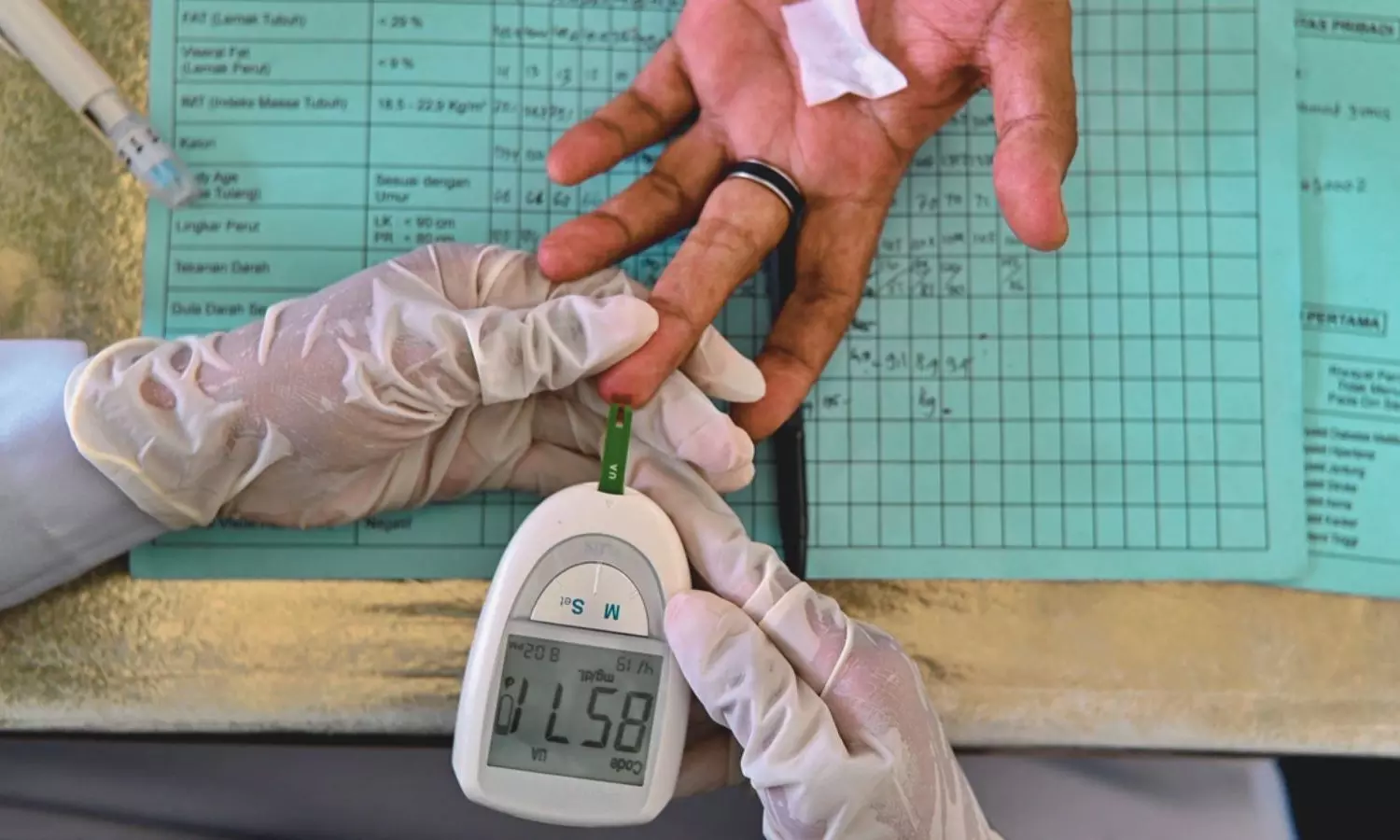Generative AI uncovers undetected bird flu exposure risks in Maryland emergency departments
Powered by WPeMatico
Powered by WPeMatico
Powered by WPeMatico
Powered by WPeMatico

China: A new secondary analysis of the Catheter Ablation vs Anti-Arrhythmic Drug Therapy for Atrial Fibrillation (CABANA) trial suggests that the benefit of catheter ablation over drug therapy in atrial fibrillation (AF) largely depends on the patient’s burden of non-modifiable recurrence risk factors (NMRRFs).
Powered by WPeMatico

In a large-scale multinational study involving over 400,000 women and men aged 37 to 70 years from six European countries, researchers from the University of Vienna, in collaboration with the International Agency for Research on Cancer (IARC) (France) and the Kyung Hee University (Republic of Korea), investigated dietary habits and disease trajectories. The comprehensive data analysis shows that a plant-based diet is associated with reduced risk of multimorbidity of cancer and cardiometabolic diseases. The study has been published in the journal The Lancet Healthy Longevity.
The study used data from two large European cohort studies, the European Prospective Investigation into Cancer and Nutrition (EPIC) study and UK Biobank. Based on data from six European countries (Italy, Spain, the United Kingdom, Germany, the Netherlands, and Denmark), the researchers provide further evidence that plant-based dietary habits can influence the development of multimorbidity. Results from the UK Biobank, for example, showed that adults with a higher adherence to a plant-based diet had a 32% lower risk of multimorbidity compared to those with a lower adherence. “You don’t have to cut out animal products entirely, “said study lead and nutritional epidemiologist Reynalda Córdova. “Shifting towards a more plant-based diet can already have a positive impact.” The study also examined differences in the risk of multimorbidity between middle-aged and older adults. Higher adherence to a plant-based diet was associated with a lower risk of cancer and cardiometabolic multimorbidity in both adults younger than 60 years and in those aged 60 years or older. Multimorbidity describes the occurrence of two or more chronic diseases in one person and is a growing health problem worldwide, particularly among adults 60 years and older.
The results: A stronger adherence to a healthy plant-based diet was associated with a lower risk of cancer, cardiometabolic disease (diabetes and cardiovascular diseases), and multimorbidity, both in adults under 60 and those over 60. “Our study highlights that a healthy, plant-based diet not only influences individual chronic diseases but can also reduce the risk of developing multiple chronic diseases at the same time, in both middle-aged and older people,” Córdova summarized.
“The results show how important a predominantly plant-based diet is for our health and thus reinforce the new Austrian dietary recommendations, which emphasize plant-based food with a low proportion of animal-based foods. A co-benefit of a plant-based diet are lower greenhouse gas emissions and land use,” adds Karl-Heinz Wagner form the University of Vienna, co-author of the study and president of the Austrian Society for Nutrition.
A healthy plant-based dietary pattern included for example, a higher intake of fruits, vegetables, whole grains, legumes and vegan sausages or burgers and a lower intake of meat and meat products. The findings suggest that a diet consisting mainly of healthy plant foods and small amounts of animal-based foods can contribute to maintaining health into older age.
The authors conclude that dietary guidelines, public health measures, and interventions should consider that a diet primarily composed of plant-based foods with small amounts of animal-based products may help prevent multimorbidity related to cancer and cardiometabolic diseases.
Reference:
Córdova, Reynalda et al., Plant-based dietary patterns and age-specific risk of multimorbidity of cancer and cardiometabolic diseases: a prospective analysis, The Lancet Healthy Longevity, DOI:10.1016/j.lanhl.2025.100742
Powered by WPeMatico

China: Researchers have found in a recent study that portable handheld ultrasound devices can provide reliable VExUS (Venous Excess Ultrasound) assessments in critically ill patients while significantly reducing examination time compared to conventional ultrasound. The findings, published in the Journal of Critical Care, suggest that this approach can enhance efficiency in intensive care units (ICUs) without compromising diagnostic accuracy.
Powered by WPeMatico

Research shows that younger men with type 2 diabetes face higher risks of mortality and cardiovascular disease compared to those with type 1 diabetes. In contrast, women experience worse outcomes with type 1 diabetes across all age groups.
The first study of its kind to compare cardiovascular risk in type 1 diabetes (T1D) and type 2 diabetes (T2D) in both men and women shows that younger men with T2D have worse mortality and cardiovascular disease (CVD) outcomes than those with T1D, whereas for women of all ages, almost all outcomes are worse for T1D than for T2D. The study is by Dr Vagia Patsoukaki, Uppsala University, Uppsala, Sweden, and colleagues and is presented at this year’s Annual Meeting of the European Association for the Study of Diabetes (EASD) in Vienna, Austria (15-19 September).
CVD is the leading cause of death and morbidity worldwide and individuals with T1D or T2D are at greater risk compared to the general population. While previous research has extensively explored the impact of diabetes on CVD, no studies have directly compared CVD risk between T1D and T2D within each sex. This new research aims to systematically compare CVD risk in T1D and T2D separately for men and women, identifying potential disparities in risk factors, disease progression, and clinical outcomes.
Diabetes patients aged 18-84 years in the Swedish National Diabetes Register (NDR) with established T1D or T2D were included in a longitudinal cohort study from January 1, 2016, with five-year follow-up until December 31, 2020. The authors analysed time-to-first event for heart attack (myocardial infarction [MI]), heart failure (HF) as a primary diagnosis, stroke, cardiovascular (CV) mortality, and all-cause mortality using data from the National Patient Registry (NPR) and Cause of Death Registry (CoDR).
Statistical modelling, adjusted for age and diabetes type, was performed separately for males and females, with results provided as Hazard Ratios (HR). Age groups (<50, 50-59, 60-69, ≥70 yr) were stratified, and overall MI, HF, and stroke risk was analysed as all CVD.
A total of 404,026 diabetes patients were included (38,351 T1D; 365,675 T2D), with 233,858 males (56%) and 170,168 females (42%). Males with T2D under 50 years had a 51% higher risk of all CVD, a 2.4 times increased risk of MI, and a 2.2 times increased risk of HF than T1D males. Above 50 years, the risk of T1D becomes higher than T2D – for men aged 50–59, there was a small, non-significant trend toward higher CVD risk in T1D compared with T2D (around 3%). However, by ages 60–69, this trend became significant: men with T2D had a 22% lower risk of heart attack than those with T1D. Men over 70 years with T2D had a 26% lower MI risk than those with T1D, but no significant differences in other outcomes.
In individuals under the age of 50, the risk for all CVD was significantly higher (by 51%) for T2D males compared to T1D males, however for females under 50, there was an observed trend to higher risk for those with T1D, though not statistically significant. Females over 50 with T2D had lower CVD and MI risks than T1D. In the 50-59 age group, risk was 25% lower for all CVD and 41% lower for MI. Between 60-69 years, the risk was lower by 27% for all CVD and by 47% for MI in T2D compared to T1D. In individuals older than 70 years and T2D, the risk was lower by 17% for all CVD and by 44% for MI compared to T1D of same age.
Similar trends in women across all ages combined were observed for CV mortality (34% lower) and all-cause mortality (19% lower) for women with T2D than T1D, significantly for those over 50 years of age. Specifically, in ages between 50-59 the risk was lower by 38% and 18%, in ages between 60-69 by 30% and 15%, and in ages over 70 by 31% and 17%, for CV mortality and all-cause mortality, respectively.
Dr Patsoukaki explains: “Women with type 1 diabetes often develop the disease at a young age, so they live with it longer which increasing their lifetime risk of heart and blood vessel problems. They may also lose some of the natural protection women usually have against heart disease, and often receive less aggressive treatment for cardiovascular disease than men.
“In contrast, younger men with type 2 diabetes (T2D) tend to have more risk factors like obesity, high blood pressure, and unhealthy lifestyles. Their diabetes is often more aggressive, and they may be diagnosed later, making their early outcomes worse. Even though being female is generally protective, in T1D that protection is weaker, possibly due to longer exposure to high blood sugar.”
After adjusting for established risk factors, female sex was protective in both diabetes types overall by 35% for all CVD, when analysing female vs males considering the whole study population together, independent of diabetes type. Similarly, being female with either diabetes type versus being male lowered the risk for MI by 39%, for CV-mortality by 34% and for all-cause mortality by 31%.
These risk factors included cardiovascular risk factors, such as blood pressure, cholesterol, blood sugar control, kidney function, smoking, body weight, physical activity, education, and how long a person has had diabetes – and adjustment helped to isolate the effect of biological sex on health outcomes. The data showed that being female was linked to a lower risk of cardiovascular disease and death compared to being male. Dr Patsoukaki explains: “This is likely due to natural biological differences, particularly at younger ages. For example, women generally have some hormonal protection, especially from oestrogen, which supports healthier blood vessels. They also tend to carry fat in ways that are less harmful to the heart and often have more favourable cholesterol profiles.”
Interestingly, this protective effect of being female was seen in both types of diabetes, but it was less pronounced in women with type 1 diabetes compared to those with type 2. This may be because women with type 1 diabetes are often diagnosed early in life, resulting in many more years of exposure to high blood sugar levels, which can gradually damage the heart and blood vessels and reduce the natural advantage that women typically have. This finding also highlights the importance of more effective and intensive management of modifiable risk factors, such as HbA1c and blood pressure, in women with type 1 diabetes, in order to further lower their risk of cardiovascular disease and mortality. At the same time, men with diabetes should also remain a key focus, as they are generally at higher risk for these outcomes.
In the age and sex adjusted model, women with T1D had worse outcomes than those with T2D, most likely due to having diabetes from a younger age, meaning longer exposure to high blood sugar and a higher total disease burden over time.
However, after adjusting for multiple risk factors, like age, blood sugar levels (HbA1c), kidney function, blood pressure, cholesterol, smoking, and diabetes duration, T2D showed a higher underlying cardiovascular risk than T1D for both sexes. Dr Patsoukaki explains: “This is because type 2 diabetes often clusters with more damaging risk factors, such as obesity, high blood pressure, and inflammation which make it more dangerous when all else is equal.”
In a further analysis based on the same cohort, the authors found that the duration of the disease plays a critical role regarding the findings in a fully adjusted analysis. Individuals with T1D have the disease for much longer compared to T2D. When the duration of disease is removed from the model, T2D appeared to be a stronger risk factor for all the studied outcomes compared to T1D. This apparent reversal is explained by diabetes duration. In this cohort, people with T1D had lived with the disease much longer on average (24 years) than those with T2D (9.2 years). Including duration in the models therefore shifts part of the excess risk to T1D, reflecting the long-term damage caused by decades of high blood sugar (hyperglycaemia) rather than an immediate effect of T1D itself. When duration is removed from the analysis, the underlying risk factors typical of T2D—such as obesity, high blood pressure, and inflammation-become more apparent, making T2D seem more hazardous in the short to medium term.
Dr Patsoukaki explains: “In other words, type 1 diabetes carries high lifetime risk due to prolonged exposure from a young age, while type 2 diabetes carries high inherent risk because of its clustering with other damaging factors. These findings highlight the need for early and aggressive risk factor management in type 1 diabetes, and continued intensive prevention in type 2 diabetes.
The authors conclude: “Younger males with type 2 diabetes had higher CVD and mortality risks than those with type 1 diabetes. In contrast, females of all ages and with type 1 diabetes had significantly higher risk compared to type 2 diabetes for almost all outcomes. A similar trend was found in men over 60 for heart attacks. While female sex was generally protective, this was less pronounced in type 1 diabetes. These findings highlight key sex differences in cardiovascular risk between diabetes types, fact that can guide clinical risk assessment and management.”
Reference:
Younger men have higher risk for mortality and cardiovascular disease for type 2 diabetes than type 1 diabetes; whereas for women type 1 diabetes outcomes are worse at all ages, European Association for the Study of Diabetes, Meeting: Annual Meeting of the European Association for the Study of Diabetes (EASD).
Powered by WPeMatico

A recent study published in the Journal of American Medical Association revealed that adding argatroban or eptifibatide to intravenous thrombolysis did not improve reperfusion rates or clinical outcomes in patients undergoing endovascular thrombectomy. The findings from the Multi-Arm Optimization of Stroke Thrombolysis (MOST) trial was conducted between 2019 and 2023. The study followed patients for 90 days, assessing outcomes in a blinded fashion.
Of 5,376 patients screened for eligibility, 4,332 did not meet inclusion criteria and another 530 were either not consented or excluded for other reasons. Ultimately, 514 patients were randomized into the trial. Among them, 254 were planned for thrombectomy, where 110 received placebo, 31 argatroban (a direct thrombin inhibitor), and 113 eptifibatide (a glycoprotein platelet inhibitor).
Of these, 219 patients ultimately underwent thrombectomy. Their average age was 68 years, and 53% were women. The trial measured recovery using the utility-weighted modified Rankin Scale (UW-mRS) at 90 days, where higher scores indicate better functional outcomes. Mean scores were 6.68 (95% CI, 5.98–7.39) in placebo group, 6.47 (95% CI, 5.79–7.15) in eptifibatide group and 5.35 (95% CI, 4.13–6.58) in argatroban group
These results show no significant improvement in clinical outcomes with the addition of either drug compared to placebo. Reperfusion success was defined by a Thrombolysis in Cerebral Infarction (TICI) score of 2b/2c/3 on completion angiography. The rates of good reperfusion were 83% (83 of 92 patients) for placebo, 84% (82 of 98 patients) for eptifibatide and 63% (17 of 27 patients) for argatroban. Rates of symptomatic intracranial hemorrhage were similar across all groups, indicating no excess bleeding risk with the experimental agents.
The results highlight that adding blood-thinning agents like argatroban or eptifibatide to intravenous thrombolysis does not improve outcomes in patients undergoing thrombectomy. However, this study suggest that future studies might explore whether these agents could benefit patients who are not candidates for intravenous thrombolysis. Overall, the findings of the MOST trial provide crucial clarity in refining acute stroke care strategies, showing that for now, standard intravenous thrombolysis followed by thrombectomy remains the optimal pathway.
Source:
Rines, I., Adeoye, O., Barreto, A. D., Broderick, J., Carrozzella, J., Chen, H., Concha, M., Elm, J., Grotta, J. C., Jasne, A. S., Khatri, P., Roy, A., Vagal, A., Wintermark, M., Yoo, A. J., Derdeyn, C. P., & MOST Investigators. (2025). Intravenous argatroban or eptifibatide in patients undergoing mechanical thrombectomy: A subgroup analysis of the MOST randomized clinical trial: A subgroup analysis of the MOST randomized clinical trial. JAMA Neurology. https://doi.org/10.1001/jamaneurol.2025.2794
Powered by WPeMatico

Researchers have found in a Veterans Health Administration study that individuals with gout are significantly more likely to be prescribed chronic opioids compared to those without gout, with an adjusted hazard ratio of 1.30. Thus Gout Patients Face Higher Risk of Chronic Opioid Use. This study was published in the Arthritis Care & Research journal by Lindsay N. and colleagues.
Despite the fact that opioids are often prescribed for the treatment of acute flares of gout, the long-term consequences of opioid exposure for patients with gout have not been well established. Long-term opioid use is linked to serious adverse health consequences, including dependence and overdose. In order to bridge this gap, investigators conducted a large matched cohort study within the VA system to assess whether gout patients are at higher risk for chronic opioid prescription relative to non-gout patients.
This was a matched cohort investigation based on national VA data. Patients who had gout were identified by validated diagnostic codes and matched to up to 10 non-gout controls according to age, sex, and year of VA entry. The main outcome was receipt of chronic opioids, measured using a validated administrative algorithm.
Statistical analysis was carried out with the help of multivariable Cox regression, after controlling for demographic variables, comorbidities, and treatment variables. Further, subgroup analyses were performed in the population of gout patients to determine independent predictors of chronic opioid exposure.
Results
The cohort was followed up for a mean of 4.52 years. Among them, 6.9% of patients with gout and 3.8% of non-gout controls received chronic opioids.
Following covariate adjustment, receipt of chronic opioids remained associated with gout, with an adjusted hazard ratio (aHR) of 1.30 (95% CI: 1.28–1.32).
6.9% of gout patients compared to 3.8% of controls were exposed to chronic opioids.
30% increased adjusted risk of exposure to chronic opioids in gout (aHR 1.30).
Median follow-up: 4.52 years.
Increased risk groups: women, younger patients, non-Hispanic Black patients, rural residents, smokers, underweight/obese patients, and those with increased comorbidity.
Rheumatology referral and urate-lowering treatment were associated with increased odds of chronic opioid fills.
This research proved that patients with gout are at significantly greater risk for chronic opioid exposure than those without gout. The risk was heightened in particular populations, such as women, racial minorities, rural dwellers, and individuals with higher comorbidities. These findings underscore the imperative to optimize gout treatment approaches and to examine whether optimizing disease care can decrease opioid dependence.
Reference:
Powered by WPeMatico

Researchers have ascertained in a new study that Ostomy-AKI patients have more complex outcomes and higher mortality compared to General-AKI. The study draws attention to the fact that Ostomy-AKI is strongly associated with hypovolemia, more severe AKI staging, and a 2.5 times higher risk of major adverse kidney events (MAKE) at 30-90 days, including mortality, dialysis requirement, or severe kidney function decrease. The study was published in the journal of Kidney Medicine by Juan A. and colleagues.
Ostomies, made most often after cancer resections, can yield high fluid output, which puts patients at risk of dehydration and renal injury. The evidence from this study is crucial in identifying how such patients clinically differ from patients with AKI of other causes.
The retrospective cohort study was conducted at the Hospital Civil of Guadalajara between February 2020 and October 2023 and included 84 patients with ostomy-associated acute kidney injury (Ostomy-AKI) and 348 patients with general acute kidney injury (General-AKI). Ostomy-AKI patients were more frequently male compared to General-AKI patients (78.7% vs 56.2%), with a median interval of 2.3 months between ostomy formation and the development of AKI.
The primary indication for ostomy creation was cancer, accounting for 46% of cases. Clinically, patients with Ostomy-AKI had a mean ostomy output of 980 ml/day (range: 760–1700 ml), and 82.9% required fluid adjustment during management. The primary endpoints evaluated were major adverse kidney events (MAKE) at 10 days (MAKE10) and at 30–90 days (MAKE30–90), defined as death, initiation of new dialysis, or a ≥25% decline in estimated glomerular filtration rate (eGFR).
Key Findings
Etiology of AKI:
• Hypovolemia was more frequent in Ostomy-AKI (48.9% vs 24.5%)
Severity of AKI (Stage 3):
• Ostomy-AKI: 82.9%
• General-AKI: 63.9%
MAKE at 10 days (MAKE10):
• Both groups: 94% (no difference)
MAKE at 30–90 days (MAKE30-90):
• Ostomy-AKI: 65.9%
• General-AKI: 49.3%
• Mortality (30–90 days):
• Ostomy-AKI: 59.5%
• General-AKI: 37%
• Ostomy-AKI doubled the risk of death (OR 2.757, CI 1.273–5.973, p=0.01)
Risk of MAKE30-90:
• Ostomy-AKI increased the risk 2.4 times (OR 2.403, CI 1.090–5.299, p=0.03)
Compared to General-AKI, Ostomy-AKI patients have a greater frequency of hypovolemia, more severe AKI, and adverse long-term outcomes, such as 59.5% mortality and a 2.5-fold increase in MAKE risk at 30–90 days. The findings emphasize the importance of aggressive kidney care in patients after recent ostomy surgery to minimize the burden of kidney complications and promote survival.
Reference:
Powered by WPeMatico
